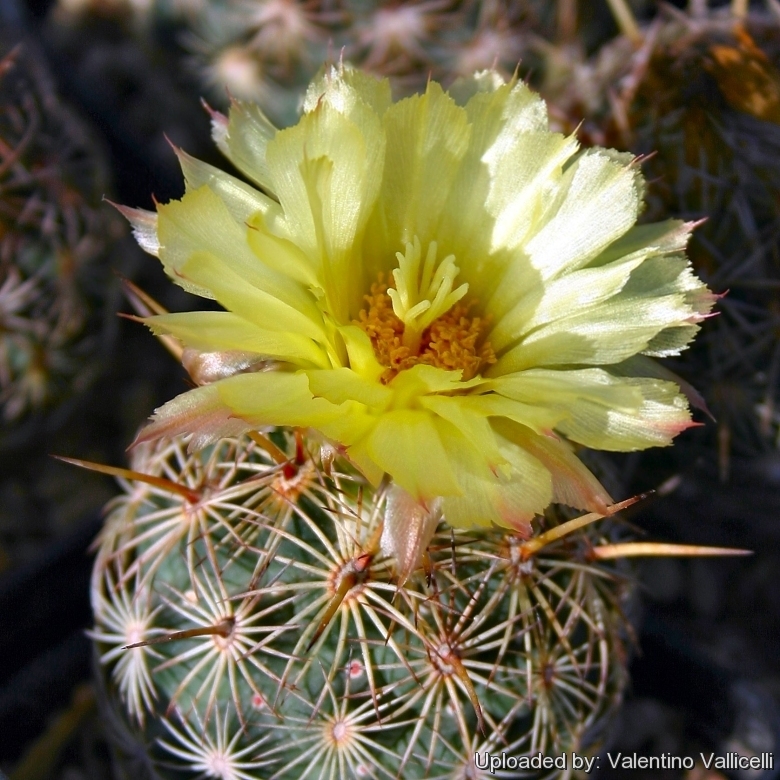
Coryphantha echinoidea Photo by: Valentino Vallicelli
SB26 (Collector Steven Brack) Salinas, SLP, Mexico
Origin and Habitat: It is found in the Mexican state of San Luis Potosí and the bordering regions of Guanajuato and Nuevo León, subsequent to its earliest description it is assumed to grow in the East of Durango, but it is almost certainly not found there.
Synonyms:
See all synonyms of Coryphantha echinoidea
back
Accepted name in llifle Database:Coryphantha echinoidea (Quehl) Britton & RoseCactaceae (Britton & Rose) 4: 30. 1923 [24 Dec 1923]Synonymy: 3
back
Description: Coryphantha echinoideaSN|10038]]SN|10204]] is a small solitary cactus with yellow flowers borne near the apex on young areoles.
Stem: Globose, to egg-shaped stems up to 6 cm high and diameter.
Spines: 20-24 radials, 1 to 3 porrect central spines 1-1.5 cm. in mature specimens;
Flowers: Large and yellow (5- 6 cm diameter) with - like the ones of the related Coryphantha vaupelianaSN|10175]]SN|10175]] and Coryphantha glanduligeraSN|10204]]SN|10038]] - a sweet fragrance. All Coryphanthas develop woolly grooves running down the tubercles as they grow towards maturity and plants will not flourish until this has happened which can take 4 years or more
Fruits: Green, club-shaped.
Remarks: This cactus produces well marked red nectary glands on the tubercles ("extra"-floral structure secreting nectar) that attract ants.
Notes: The Subgenus Neocoryphantha Backeberg is characterised by the presence of extra floral nectaries; they are glands typically located in the tubercle-grooves or in the axils. These nectary-glands are red, orange or yellow and exude in the summer and autumn a viscous juice (nectar) with a high sugar-content. These glands represent a sophisticated strategy for ant attraction.
1) The first hypothesis for why plants secrete extra floral nectar is that the presence of pugnacious ants seems to reduce the vulnerability of flower buds by herbivorous insects, resulting in greater fruit production and tissue survival. (or by decreasing seed predation on plants.)
2) The second hypothesis is that they distract ants from foraging at the floral nectaries, this might also serve as an adaptation to reduce ant visitation to flowers.
3) The third hypothesis is the nutrient enhancement. Ant colonies tend to concentrate on nutrients in the immediate vicinity of their nests - through storing food, discarding debris, and defecating. Plants that bear extra floral nectar, attract ant nests to their base.
4) Moreover ants can play an important rule in distributing the seeds of these Coryphanthas. (see: Myrmecochory )
Bibliography: Major references and further lectures
1) Edward Anderson “The Cactus family” Timber Press, Incorporated, 2001
2) James Cullen, Sabina G. Knees, H. Suzanne Cubey "The European Garden Flora Flowering Plants: A Manual for the Identification of Plants Cultivated in Europe, Both Out-of-Doors and Under Glass" Cambridge University Press, 11/Aug/2011
3) David R Hunt; Nigel P Taylor; Graham Charles; International Cactaceae Systematics Group. "The New Cactus Lexicon" dh books, 2006
4) Gómez-Hinostrosa, C., Hernández, H.M., Goettsch, B.K., Lüthy, A.D. & Dicht, R.F. 2013. Coryphantha glanduligera. The IUCN Red List of Threatened Species 2013: e.T152803A680350. http://dx.doi.org/10.2305/IUCN.UK.2013-1.RLTS.T152803A680350.en. Downloaded on 01 May 2017.
5) Reto Dicht, Adrian Lüthy “Coryphantha: Cacti of Mexico and Southern USA” Springer Science & Business Media, 14 mar 2006
6) Nathaniel Lord Britton, Joseph Nelson Rose “Cactaceae: Descriptions and Illustrations of Plants of the Cactus Family” vol. 4 The Carnegie Institution of Washington, Washington 1923
7) Dicht, R.F. 1998. “Coryphantha glanduligera (Otto) Lemaire - Rehabilitation of a forgottem taxon.” The Journal of the Mammillaria Society 38(1): 2.
8) Urs Eggli, Leonard E. Newton “Etymological Dictionary of Succulent Plant Names”. Springer, Berlin/Heidelberg 2010
9) Albert Dietrich “Beiträge zur Cacteenkunde, mitgetheilt aus der Linke'sche[n] Sammlung in Berlin”. In: Allgemeine Gartenzeitung. Band 16, Nummer 38, 16. September 1848, S. 298 (online).
10) Charles Lemaire “Les Cactées Histoire, Patrie Organes de Vegetation, Inflorescence Culture etc.” Paris 1868
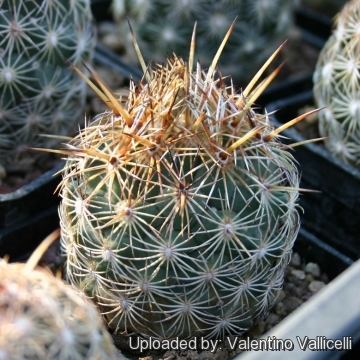 Coryphantha echinoidea Photo by: Valentino Vallicelli
Coryphantha echinoidea Photo by: Valentino Vallicelli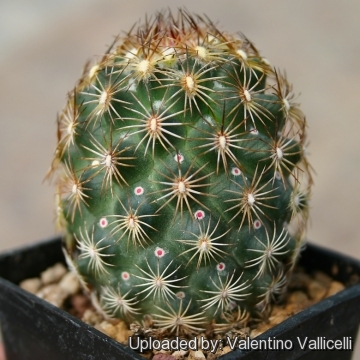 The red extrafloral nectaries attract the ants that defend the plant against dangerous herbivore insects. Photo by: Valentino Vallicelli
The red extrafloral nectaries attract the ants that defend the plant against dangerous herbivore insects. Photo by: Valentino Vallicelli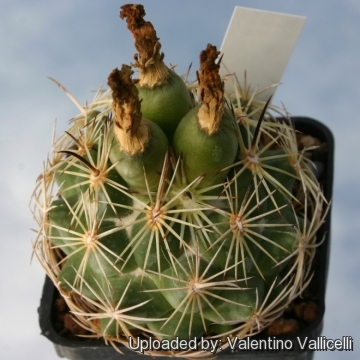 Coryphantha echinoidea Photo by: Valentino Vallicelli
Coryphantha echinoidea Photo by: Valentino Vallicelli Coryphantha echinoidea Photo by: Valentino Vallicelli
Coryphantha echinoidea Photo by: Valentino Vallicelli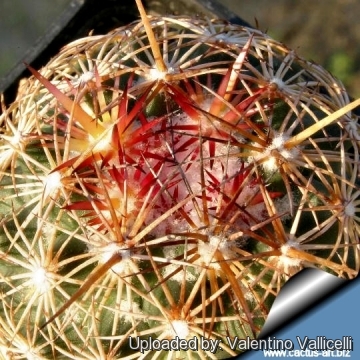 Coryphantha echinoidea Photo by: Valentino Vallicelli
Coryphantha echinoidea Photo by: Valentino Vallicelli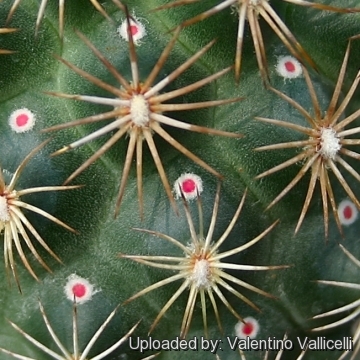 Coryphantha echinoidea Photo by: Valentino Vallicelli
Coryphantha echinoidea Photo by: Valentino Vallicelli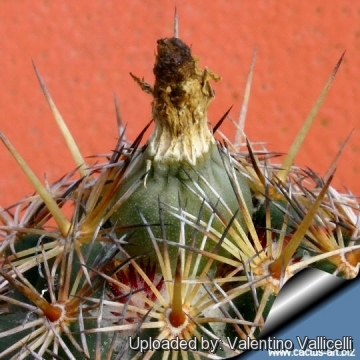 Fruit at the apex among the porrect central spenes. Photo by: Valentino Vallicelli
Fruit at the apex among the porrect central spenes. Photo by: Valentino Vallicelli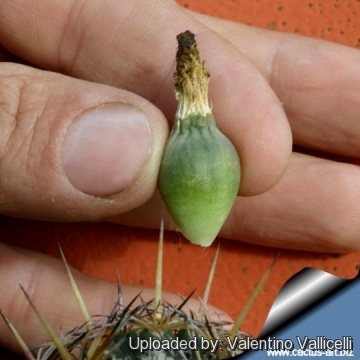 Coryphantha echinoidea Photo by: Valentino Vallicelli
Coryphantha echinoidea Photo by: Valentino VallicelliCultivation and Propagation: Easily grown in normal cactus compost, requires good drainage. Water in moderation, keep drier in winter. Full sun to partial shade. In humid conditions, the exudation of nectar (if not completely removed by ants) can cause the formation of mould which leads to ugly black-colouring of the epidermis. To prevent this, spray the plant with water to remove the nectar. And provide very good ventilation.


















